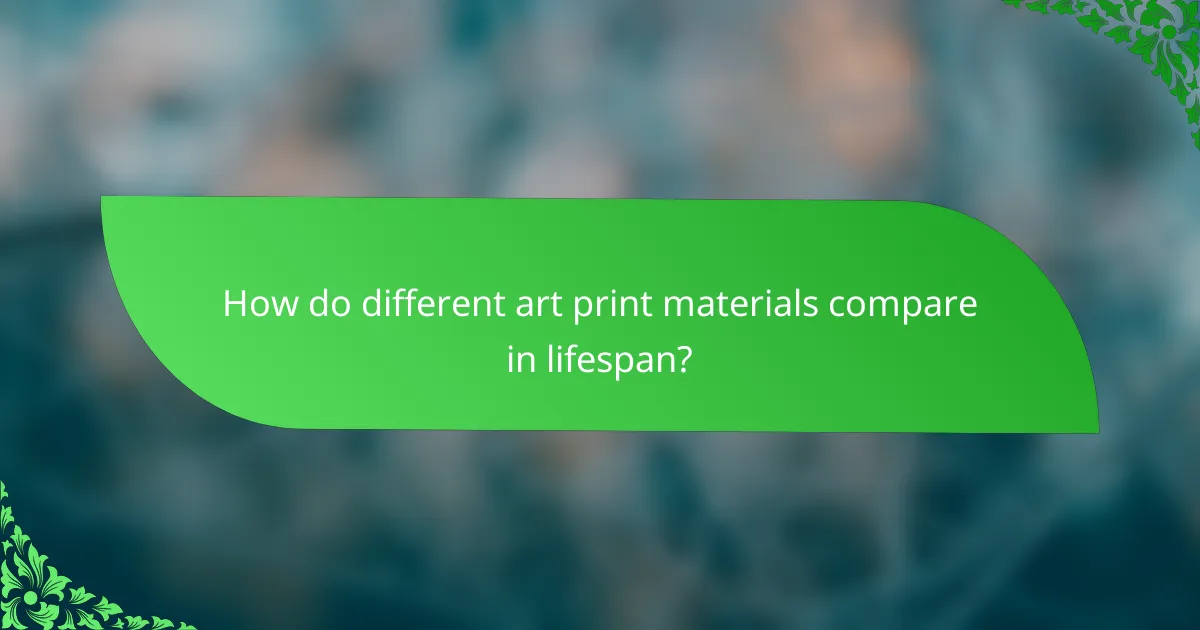The choice of material for art prints plays a crucial role in determining their durability and longevity. Factors such as exposure to light, humidity, and temperature fluctuations can significantly affect how well different materials withstand the test of time. Selecting high-quality options like archival paper or wood panels can enhance the lifespan and overall quality of your artwork.

How does art print material affect durability in the UK?
The material used for art prints significantly influences their durability and longevity. In the UK, factors such as exposure to light, humidity, and temperature fluctuations can affect how well different materials hold up over time.
Canvas prints offer high durability
Canvas prints are known for their robust nature, making them a popular choice for both home and gallery displays. They are typically made from cotton or polyester, which provides a strong surface that can withstand wear and tear.
When properly stretched and mounted, canvas prints can last for decades without significant fading or damage. To enhance their lifespan, consider using UV-protective coatings and placing them away from direct sunlight.
Metal prints resist fading and scratches
Metal prints are another durable option, as they are made from aluminum and coated with a special finish that resists fading and scratches. This makes them ideal for high-traffic areas or environments where prints may be exposed to moisture.
These prints are lightweight and can be easily cleaned, which adds to their practicality. However, it’s essential to ensure they are hung securely to prevent any accidental falls, which could cause damage.

What are the best materials for art prints in the US?
The best materials for art prints in the US include archival paper and wood panels, both known for their durability and longevity. Choosing the right material can significantly impact the lifespan and quality of your artwork.
Archival paper for longevity
Archival paper is designed to resist deterioration over time, making it an excellent choice for art prints. This type of paper is typically acid-free and made from high-quality materials, ensuring that prints maintain their color and integrity for decades.
When selecting archival paper, look for options that meet standards set by organizations like the American National Standards Institute (ANSI). Common choices include cotton rag and alpha cellulose papers, which offer superior durability and resistance to fading.
To maximize longevity, store prints in a cool, dry environment and avoid direct sunlight. Using UV-protective glass when framing can further enhance the lifespan of prints on archival paper.
Wood panel for stability
Wood panels provide a stable and durable surface for art prints, making them less prone to warping or bending compared to traditional paper. They are often used for mounting prints, offering a modern aesthetic and added protection.
When choosing wood panels, consider options like birch or maple, which are popular for their strength and smooth finish. Ensure the wood is properly sealed to prevent moisture damage and to enhance the print’s longevity.
For best results, use a professional mounting technique that minimizes air bubbles and ensures a tight bond between the print and the panel. This will help maintain the artwork’s appearance and stability over time.

How do different art print materials compare in lifespan?
Different art print materials exhibit varying lifespans, significantly impacting their durability and longevity. Factors such as exposure to light, humidity, and the quality of the material itself play crucial roles in determining how long a print will last.
Canvas vs. paper lifespan
Canvas prints typically last longer than paper prints due to their robust texture and resistance to wear. High-quality canvas can endure for several decades, especially when properly stretched and framed, while paper prints may begin to fade or deteriorate within a few years if not protected.
To maximize the lifespan of paper prints, consider using acid-free paper and UV-protective glass when framing. This can help prevent yellowing and fading, extending the print’s life to potentially 20 years or more under ideal conditions.
Metal vs. acrylic durability
Metal prints are known for their exceptional durability, often lasting over 50 years without significant fading or damage. They are resistant to moisture and scratches, making them ideal for high-traffic areas or outdoor displays.
Acrylic prints, while visually striking, can be more susceptible to scratching and may require careful handling. However, when treated properly, they can also last for decades. Choosing high-quality acrylic and ensuring it is mounted securely can enhance its longevity.

What factors influence the longevity of art prints?
The longevity of art prints is primarily influenced by environmental conditions and the quality of the ink used. These factors can significantly affect how well a print withstands time, fading, and physical degradation.
Environmental conditions impact durability
Environmental factors such as temperature, humidity, and exposure to light play a crucial role in the durability of art prints. High humidity can lead to mold growth, while excessive heat can cause inks to fade or paper to warp.
To enhance longevity, store prints in a cool, dry place away from direct sunlight. Using UV-filtering glass when framing can also protect prints from harmful light exposure, extending their life significantly.
Quality of ink affects print life
The type and quality of ink used in printing directly influence the lifespan of art prints. Pigment-based inks generally offer better longevity compared to dye-based inks, as they are more resistant to fading and environmental damage.
When selecting prints, look for those made with archival-quality inks, which are designed to last for decades without significant deterioration. Additionally, consider prints that adhere to industry standards for longevity, such as those certified by organizations like the Fine Art Trade Guild.

How to choose the right material for your art print?
Choosing the right material for your art print is crucial for ensuring its durability and longevity. Factors such as the print’s intended display location, budget, and aesthetic preferences will influence your decision.
Consider intended display location
The display location significantly impacts the choice of material for your art print. For instance, prints hung in bright, sunlit areas may require UV-resistant materials to prevent fading, while those in humid environments should be made from moisture-resistant substrates.
Common materials include canvas, which offers a textured look and is suitable for various environments, and photo paper, which provides a glossy finish ideal for indoor displays. Consider how the material will withstand environmental factors like light and humidity.
Evaluate budget and aesthetic preferences
Your budget will play a key role in determining the material for your art print. Canvas prints can range from affordable options in the low tens of USD to high-end pieces costing several hundred USD, depending on quality and size. Photo paper typically falls within a similar price range.
Aesthetic preferences should also guide your choice. For a modern look, acrylic prints can provide a sleek finish, while traditional frames with matte paper may suit a classic style. Weigh the visual impact against your budget to find a balance that meets your needs.

What are the emerging trends in art print materials?
Emerging trends in art print materials focus on sustainability and advanced protective features. Artists and consumers are increasingly seeking options that not only enhance the visual appeal but also ensure longevity and minimal environmental impact.
Sustainable materials gaining popularity
Sustainable materials are becoming a key choice for art prints, driven by a growing awareness of environmental issues. Options like recycled paper, organic cotton, and bamboo are favored for their reduced ecological footprint.
Using sustainable materials often means prints are produced with non-toxic inks and processes, which can enhance safety for both artists and consumers. Many artists are now opting for these eco-friendly alternatives to appeal to environmentally conscious buyers.
Innovative coatings for enhanced protection
Innovative coatings are being developed to improve the durability of art prints, protecting them from UV light, moisture, and physical damage. These coatings can significantly extend the lifespan of prints, making them more resilient in various environments.
Common options include UV-resistant varnishes and anti-scratch finishes, which can be applied to a variety of materials. Artists should consider these coatings when selecting print materials to ensure their work remains vibrant and intact over time.
